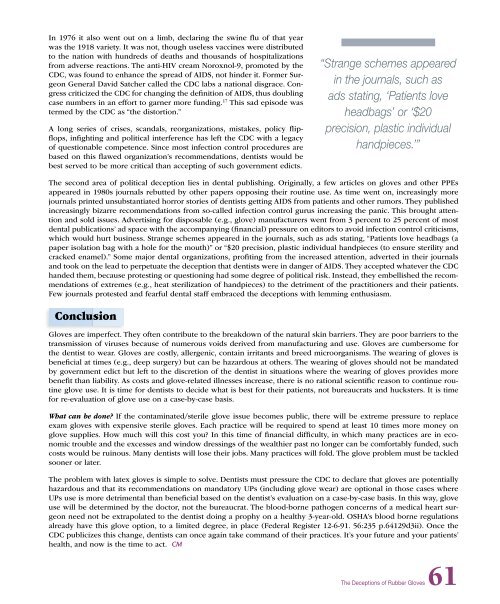PDF Version - Glidewell Dental Labs
PDF Version - Glidewell Dental Labs
PDF Version - Glidewell Dental Labs
You also want an ePaper? Increase the reach of your titles
YUMPU automatically turns print PDFs into web optimized ePapers that Google loves.
In 1976 it also went out on a limb, declaring the swine flu of that year<br />
was the 1918 variety. It was not, though useless vaccines were distributed<br />
to the nation with hundreds of deaths and thousands of hospitalizations<br />
from adverse reactions. The anti-HIV cream Noroxnol-9, promoted by the<br />
CDC, was found to enhance the spread of AIDS, not hinder it. Former Surgeon<br />
General David Satcher called the CDC labs a national disgrace. Congress<br />
criticized the CDC for changing the definition of AIDS, thus doubling<br />
case numbers in an effort to garner more funding. 17 This sad episode was<br />
termed by the CDC as “the distortion.”<br />
A long series of crises, scandals, reorganizations, mistakes, policy flipflops,<br />
infighting and political interference has left the CDC with a legacy<br />
of questionable competence. Since most infection control procedures are<br />
based on this flawed organization’s recommendations, dentists would be<br />
best served to be more critical than accepting of such government edicts.<br />
“Strange schemes appeared<br />
in the journals, such as<br />
ads stating, ‘Patients love<br />
headbags’ or ‘$20<br />
precision, plastic individual<br />
handpieces.’”<br />
The second area of political deception lies in dental publishing. Originally, a few articles on gloves and other PPEs<br />
appeared in 1980s journals rebutted by other papers opposing their routine use. As time went on, increasingly more<br />
journals printed unsubstantiated horror stories of dentists getting AIDS from patients and other rumors. They published<br />
increasingly bizarre recommendations from so-called infection control gurus increasing the panic. This brought attention<br />
and sold issues. Advertising for disposable (e.g., glove) manufacturers went from 3 percent to 25 percent of most<br />
dental publications’ ad space with the accompanying (financial) pressure on editors to avoid infection control criticisms,<br />
which would hurt business. Strange schemes appeared in the journals, such as ads stating, “Patients love headbags (a<br />
paper isolation bag with a hole for the mouth)” or “$20 precision, plastic individual handpieces (to ensure sterility and<br />
cracked enamel).” Some major dental organizations, profiting from the increased attention, adverted in their journals<br />
and took on the lead to perpetuate the deception that dentists were in danger of AIDS. They accepted whatever the CDC<br />
handed them, because protesting or questioning had some degree of political risk. Instead, they embellished the recommendations<br />
of extremes (e.g., heat sterilization of handpieces) to the detriment of the practitioners and their patients.<br />
Few journals protested and fearful dental staff embraced the deceptions with lemming enthusiasm.<br />
Conclusion<br />
Gloves are imperfect. They often contribute to the breakdown of the natural skin barriers. They are poor barriers to the<br />
transmission of viruses because of numerous voids derived from manufacturing and use. Gloves are cumbersome for<br />
the dentist to wear. Gloves are costly, allergenic, contain irritants and breed microorganisms. The wearing of gloves is<br />
beneficial at times (e.g., deep surgery) but can be hazardous at others. The wearing of gloves should not be mandated<br />
by government edict but left to the discretion of the dentist in situations where the wearing of gloves provides more<br />
benefit than liability. As costs and glove-related illnesses increase, there is no rational scientific reason to continue routine<br />
glove use. It is time for dentists to decide what is best for their patients, not bureaucrats and hucksters. It is time<br />
for re-evaluation of glove use on a case-by-case basis.<br />
What can be done? If the contaminated/sterile glove issue becomes public, there will be extreme pressure to replace<br />
exam gloves with expensive sterile gloves. Each practice will be required to spend at least 10 times more money on<br />
glove supplies. How much will this cost you? In this time of financial difficulty, in which many practices are in economic<br />
trouble and the excesses and window dressings of the wealthier past no longer can be comfortably funded, such<br />
costs would be ruinous. Many dentists will lose their jobs. Many practices will fold. The glove problem must be tackled<br />
sooner or later.<br />
The problem with latex gloves is simple to solve. Dentists must pressure the CDC to declare that gloves are potentially<br />
hazardous and that its recommendations on mandatory UPs (including glove wear) are optional in those cases where<br />
UPs use is more detrimental than beneficial based on the dentist’s evaluation on a case-by-case basis. In this way, glove<br />
use will be determined by the doctor, not the bureaucrat. The blood-borne pathogen concerns of a medical heart surgeon<br />
need not be extrapolated to the dentist doing a prophy on a healthy 3-year-old. OSHA’s blood borne regulations<br />
already have this glove option, to a limited degree, in place (Federal Register 12-6-91. 56:235 p.64129d3ii). Once the<br />
CDC publicizes this change, dentists can once again take command of their practices. It’s your future and your patients’<br />
health, and now is the time to act. CM<br />
The Deceptions of Rubber Gloves61

















